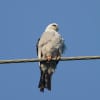 By Jim Stevenson
By Jim Stevenson
Today’s gallery is a bit unusual, but I had a young man in the fifth grade write in and ask what a kite was (other than Ben Franklin’s assistant). They are rather falcon-shaped raptors which are mostly unrelated to each other. They feed largely on warm-blooded animals, mostly rats, although some stray considerably from that fare. They usually live in tropical to subtropical zones and most soar like buteos rather than diving like falcons. They are not especially well-represented in Eurasia, and most aren’t closely-related to each other.
We have loads of room on tomorrow’s field trip, and this weekend may continue the run of excellent birding we’ve had in March. If the front gets through tonight and we get a north wind tomorrow, our field trip could be very birdy.
If I missed anyone this week who’s interested in either June’s Great Plains/California trips or Australia in July, please let me know. I’ve sent out information.
Reminder to Gull deliverers that the Gulls are ready and will be in a van at Mirror Publishing all weekend. You may pick them up. Have a great weekend!
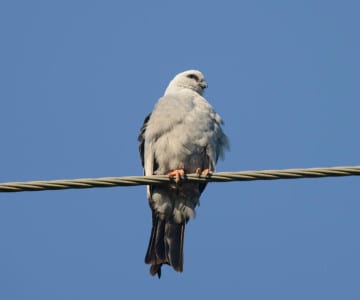
Mississippi Kites are found all over the Deep South with some further north and west (I once saw 114 in Colorado in one day!). They are summer residents which feed mostly on rats and small birds but will snatch lizards (skinks) out of trees’ canopies in late spring. They are quite common at the Smith Point Hawkwatch Tower in late August and Sept.
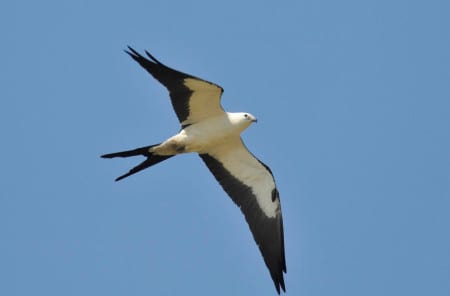
Swallow-tailed Kites are largely birds of the Deep South in swamps and damp woodlots. They arrive from Amazonas very early & leave mostly in August to return to the Tropics. Occasionally we get them flying up or down the Island in the migration but they are not a common bird in Texas. They are very common in the Florida Peninsula. This species will often pluck lizards and small snakes off branches, plus insects and treefrogs.
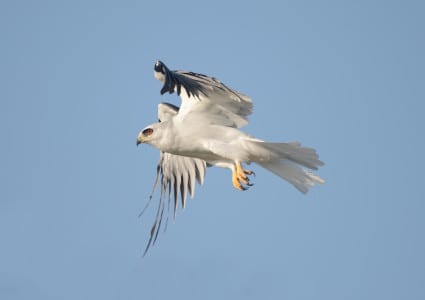
White-tailed Kites are common on the Texas and California Coasts, also ranging in good numbers through Central America and drier areas of South America. They are confirmed rat eaters, dropping off poles and wires onto much smarter but less aware Cotton Rats in fields. Their red eyes allow them to see in lower light than most birds feed in.
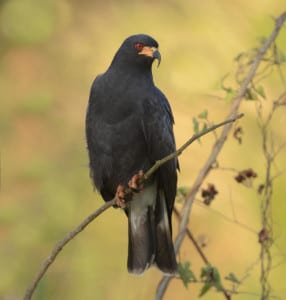
Snail Kites were once called “Everglade” Kites, but they are actually quite common in the Tropics south of us. The bill is specially adapted for puncturing the operculum of apple snails. Looking like the claw of a hammer, and often being seen in flocks, their scientific name is Rostrhamus sociabilis. This is a male, black as coal; females are brown streaked, like the immatures. (So typical of many young raptors.)
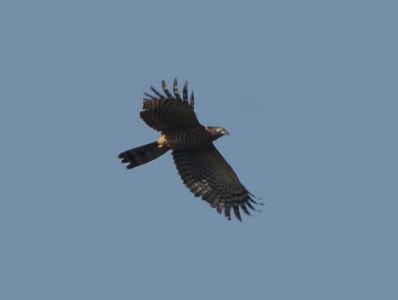
A bird only seen right along the US/Mexico Border in our Country is the Hook-billed Kite, a species which consumes land snails with gusto. Note the harrier-like form but with really broad wings. They actually range well through the Tropics, and this bird was right on the Venezuela/Brazil border, near Santa Elena.
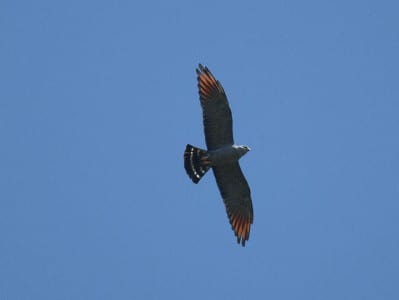
Very closely related to the Mississippi Kite is the Plumbeous Kite, differing in having the reddish color in the primaries. Like its close cousin, it migrates north and south through the Americas, with most spending the winter months in Amazonas. Many raptors have those curious tail bands, and I am want to know why. Cecilia? Roger Tory? Barack? 😉
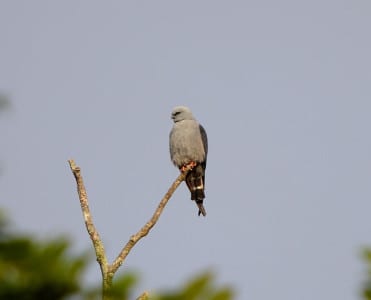
This picture of a resting Plumbeous Kite just underscores the kites’ similarity to falcons. Also curious is how many raptors have pink or yellow legs. With all the tropical birds which have shown up in the US since 2000, one wonders how long before this species make its appearance. If you don’t think it’s possible, read on…
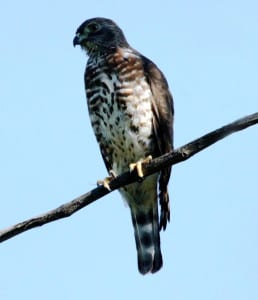
This rare kite resembles a skinny Broad-winged Hawk, but is actually the first US record of a Double-toothed Kite for North America. This was taken by my friend David Hanson, who noticed the strange bird while walking by a High Island woodlot, and sent it to me. Aside from Dave taking terrific pictures, this also illustrates the value of camera toting, as the bird was not seen again. But that magic moment was frozen in time, thank goodness.
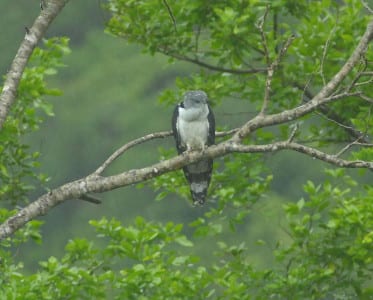
Another kite seen uncommonly in the Tropics is the Gray-headed Kite, a longish bird of scattered forests. Most kites don’t tend to sit out in the open as much as buteos (more like accipiters), but this was a nice diversion on a rainy morning with flamingos behind us. It wasn’t five seconds before he darted off the limb and smacked into a prey item below.
![One of the least-known and most seldom-seen kites is the hefty Slender-billed Kite. I have only seen this rare bird of prey in one place ever – Hatos Pinero. It certainly bears a resemblance to the Snail Kite (who also loves snails), but has more weight to carry (as cargo). [No, I won’t let that one go.] Notice the bill, suited for puncturing the operculum of the mollusk. BTW, land snails are not carnivores like their sea-dwelling cousins.](https://www.crystalbeachlocalnews.com/wp-content/uploads/2014/03/Kites10-377x300.jpg)
One of the least-known and most seldom-seen kites is the hefty Slender-billed Kite. I have only seen this rare bird of prey in one place ever – Hatos Pinero. It certainly bears a resemblance to the Snail Kite (who also loves snails), but has more weight to carry (as cargo). [No, I won’t let that one go.] Notice the bill, suited for puncturing the operculum of the mollusk. BTW, land snails are not carnivores like their sea-dwelling cousins.
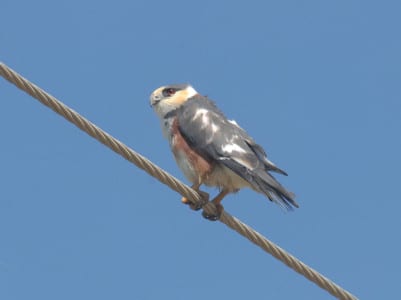
tiny Pearl Kite is scattered through the dry areas of the Tropics, trying to make kestrels look large. They take insects and mice mostly, occasionally chasing small, ground-feeding birds. Few kites perch out in the open as much as these dwarfs, and few fit the “kite” mold less, either (whatever that is).
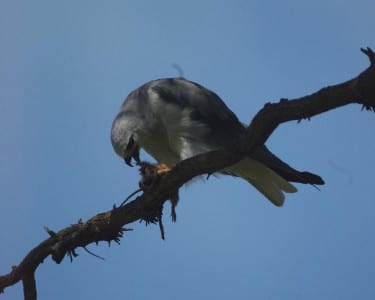
The Black-shouldered Kite of Africa is the reason we had to change the name of our White-tailed Kite decades ago. They were obviously two different species and the one named first (naturally, the Old World bird) takes precedence. Like our bird, though, it has a distinct love for rats. Notice how the shade makes this bird appear so much darker.
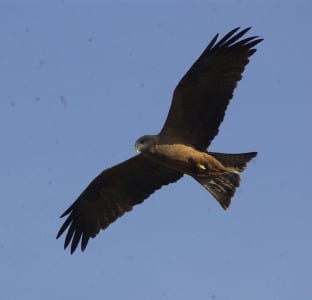
The Yellow-billed Kite of Africa reminds us of several kites in Australia, with all being closely related. They are heavily sarcophagus, competing with vultures in Africa for road kill. As with many birds that feed or nest near highways (like swallows), these roads may actually raise their populations, despite killing a fair number.
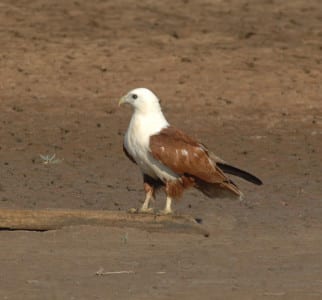
The beautiful Brahminy Kites seem attracted to aquatic areas, with this one working the dried mud near Cairns for stranded sea life. The white head and belly mirrors some of the eagles in the Old World, and even our Osprey (and theirs…). This bird has quite a large range and is worshipped in some cultures.
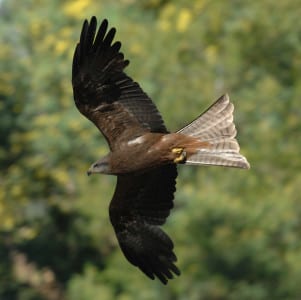
The Black Kite is quite a common bird in Australia’s dry country, often seen gliding around roadsides due to the carrion available. It’s both sad and amazing how many mammals (especially) are killed by automobiles in the Outback, especially kangaroos and wallabies. One wonders if these birds have increased with more traffic.
![Whistling Kites have quite the wing load for kites, and are told from other species by the rounded, light tail. They are the commonest of several kite species in the Outback, with Brown Falcons and Wedge-tailed Eagles also frequent. [Can you tell I’m starting to think about Australia?] The rounded wings are built to fly slow as they survey the ground for prey or carcasses.](https://www.crystalbeachlocalnews.com/wp-content/uploads/2014/03/Kites16-276x300.jpg)
Whistling Kites have quite the wing load for kites, and are told from other species by the rounded, light tail. They are the commonest of several kite species in the Outback, with Brown Falcons and Wedge-tailed Eagles also frequent. [Can you tell I’m starting to think about Australia?] The rounded wings are built to fly slow as they survey the ground for prey or carcasses.

 Posted in
Posted in 
























Who can say no the benefits of this lean green veggie.
A trim, flat stomach is an essential part of that look too.
These muscles in most cases require different flat stomach
workouts too properly eliminate the fat that has been stored up and hidden in them.
Heree is my site – metformin weight loss side effects